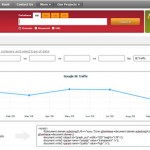Below are 20 SEO Tips for 2010 as a stocking stuffer from SEO Design Solutions to kick off the new year in style. It’s no secret that SEO involves granular changes across multiple metrics to optimize a site, yet each layer of the respective SEO onion has its place in the hierarchy of relevance which you can use to fine-tune rankings and results.
These 20 tips cover everything from the basics to some of the same SEO techniques we use daily to dominate competitive verticals. We hope you enjoy the list and feel free to add a few of your own in the comments section or pass them along to others so they can enjoy them as well.
- Canonical Issues – check canonical issues to make sure there is a preferred default page or domain preference (http:// or www).
- No reason to have 3 variations of a home page .html, .php and default.htm, depending on your programming platform, server settings (Unix or Windows) as well as if you are using static pages or a content management system you will need to consolidate your website to either http:// or http://www to avoid splitting your site into less potent slivers.
- Indexation and Crawl Frequency – See how many pages are crawled in a site to determine crawl frequency.
- If you have a home page that is crawled regularly and your internal pages are ignored, then this is often a result of lack of internal or external links.
- You can implement sitemaps on a folder by folder basis, then link from the footer in a site template to a maser sitemap page (where all the mini sitemaps are linked to) to increase indexation. This way the link from the footer consolidates the ranking factor to one page and THAT page feeds the various site maps equivocally (through a tiered drip-down site architecture effect).
- Orphaned Pages and Dead Ends – check for orphaned pages to determine if pages are linked sufficiently to ensure crawling.
- If you have a page or sub folder in a website that is only linked to from a few pages, then you cannot possibly expect that page to rank well in search engines. If you yourself will not “endorse” a page by linking to it properly (contextually from keywords in the body copy) or from the primary or secondary navigation, then you cannot possibly expect search engines to pay that page with any more credence than yourself.
- Also be weary of PDF files (which can rank on their own and sponge link flow from your website). Make sure PDF files have absolute links (use the complete URL) back to your site, so they do not pool ranking factor and trap it where the rest of your site cannot benefit.
- Dynamic URL’s – If pages are dynamically created, try to remove or rewrite as many parameters in the URL as possible or use URL / Mod rewrite.
- Any time you have session data or query string parameters in a URL, you are decreasing the possibility of indexation. Particularly if there are conventions such as ?PID=23D-55.aspx trailing along, when a SEO friendly naming convention could have taken its place with a bit of programming. You can rewrite entire segments, sub folders, categories, etc. without losing functionality or compromising SEO value.
- Naming Conventions – Use proper naming conventions (subject or keyword first, then plural variation, modifier, then tag line).
- Here is a more useful post about how to use meta titles, descriptions and naming conventions, but the gist is simple. Create a hierarchy based on a relevant platform of topically reinforcing semantics using keyword clusters and related synonyms to toggle relevance from what search engines deem as the co-occurrence matrix.
- Manage Outbound Links – Try to cap outbound links per page to fewer than 50 links for larger pages (10 for top level pages that need more ranking factor).
- The more links that leave a page, the less ranking factor the elements on that page have as equity. The only instance when this is not a concern is if the page itself is augmented from other strong internal pages or have strong inbound links from other sites to offset the hemorrhaging effects of excessive links leaving a page.
- Footer / Site wide Links – Use footer links sparingly by tactfully to tie site segments together.
- Footer links still work (using 5-10 keyword-rich text links at the bottom of a page), but that can also diffuse the intent of pages that do not have enough content to distinguish themselves from other pages. If a page in a site does not have more than 300 unique words on that page, it can lose relevance as the navigation and other code structures collapse and all interject their shingles to offset or diffuse the pages unique purpose and optimal continuity.
- For example if you have a page that is only a paragraph or two and you expect that page to rank for specific keywords, your navigation alone may trump the relevance for that page. Check your cached pages in text view to see how search engines view your code and your content without style sheets or java script .
- Footer links can help bring balance to pages with less content, but use them on pages with enough content to weather their contribution.
- Broken Links – Check for broken links which could be hemorrhaging link flow and weakening a site from within.
- Broken links irritate search engine spiders, and when they cannot connect the dots, your sites rankings suffer. If you are using WordPress our plugin SEO Ultimate features a 404 monitor that sweeps the site for broken links which you can find and eliminate.
- Alt Attributes in Images – Use alt attributes on images to preserve content integrity while providing internal links for ranking factor.
- Using the alt attribute in images allows you to reinforce topical relevance with the on page text based content to improve a pages relevance score.
- Anchor Text Optimization – Use pertinent anchor text and do not waste link equity from excessively linking to non reciprocating pages within a site.
- Employing anchor text optimization means using relevant keywords to link to relevant pages within a site. Do this enough and before you know it you are virtual theming (which means creating a secondary navigation contextually through keyword co-occurrence).
- This alone can distinguish your site from competitors as each granular layer consolidates ranking factor for a website. This alone is one reason why Wikipedia dominates search results, due to virtual theming.
- Flattening Site Architecture – Keep site architecture as flat as possible or use breadcrumbs to aid in information architecture and crawling.
- Avoid using sub folders excessively within a website domain.com/categories/products/color/page.html vs. flattening the url and site by using more descriptive naming conventions for a page domain.com/electronics-black-sports-watch.html
- The closer the more competitive keyword landing pages are to the root folder, the easier it will be for them to gain additional ranking factor, page rank and page strength to express the content on that page.
- Content Volume – Ensure you have enough content to topple a competitive keyword.
- Trying to rank for a keyword with 5 million competing pages with a handful of content is an exercise in futility. You will need topical relevance which means articles, posts or pages all internally linked and consolidated to create the proper on page signals for that keyword.
- For every keywords there is a relevance threshold and tipping point, you will need to offset competitors by having more on page affluence as well as off page peer review (links from other authorities). However, in either case, content is a requirement.
- Contextual Links – Link contextually within related document to select preferred landing pages through virtual theming.
- The premise is simple, if you are on a page about engines, and have a keyword pistons appear, then link the keyword pistons to the piston page. Do this for every keyword (only once per page if it appears more than that) and you have just added a virtual theme to your keywords. This means that each page can now work together collectively to support the parent theme (which is the main/root keyword itself).
- Meta Tags – For larger sites, exclude meta descriptions but for smaller sites, use the meta data as an extra title or place for alternative keywords.
- Always use a succinct and relevant title, but if you have multiple pages on a topic, then let search engines decide which keywords are more prominent and relevant by excluding the meta description / snippet from the page.
- Also make sure that if you are using a content management system that your pages do not all share a common, generic meta title or description as a default. This is the fastest way to shoot down rankings in a site (lack of character).
- Deep Links – Get at least 5-10 inbound links to each page via deep links from other sites in order to create buoyancy.
- A page without links either from the site itself, or other sites is a page that has little value to readers or search engines. Popularity matters and for the millions of site owners who may or may not be aware of this simple fact, you MUST have deep links to a page if you want that page to exceed standard normalization.
- A website replete with deep links (links to other pages other than the homepage) will start to have those individual pages rank and appear for multiple keywords. Not only does this create a more robust user experience, but the dependency for your rankings is not tied to an off topic or generic page like the homepage.
- The take away here is, get at least 5-10 inbound links to each page minimum (if that page is expected to gain traction) otherwise, link to another page that is the preferred landing page and get deep links to it.
- Keyword Stemming – Link to a page with multiple anchors (to create keyword stemming) and with “exact match” keywords to elevate just that term.
- You can control how each page in your website ranks by being mindful about internal and external lining habits. This post called SEO Rankings and How to Create Them provides a masterful breakdown of this process.
- RSS Feed Syndication – Set up multiple RSS feeds within a site to syndicate your content to attract natural backlinks from other sites.
- A proper RSS campaign alone can build sufficient links for your website. Combined with a content development strategy and time-released topical content, this alone can drive traffic and increase domain authority to produce rankings and relevance in even the most competitive vertical markets. This post SEO, RSS and the Power of Syndication provides SEO techniques and tactics for RSS feeds and RSS aggregation.
- Trust Rank – Linking from aged pages can pass along trust to new landing pages or sub folders or sub domains. Don’t look past your own site for ranking factor.
- Passing along trust rank can save you months of waiting for search results to mature from fresh content. Here is a post that shows you how to identify and link from older more relevant pages to new pages to augment rankings and more importantly, trust. This method is designed to augment on page SEO and consolidate ranking factor from all pages to the new preferred landing page.
- Sitemaps – Use sitemaps to not only tie the site together, but also as a way to nourish pages like an irrigation system through linking to them.
- Here are a few other useful SEO tips you can use in addition to using sitemaps to improve rankings.
- Sub Domains – Despite abuse in the past, sub domains still work.
- If your website is sagging under its own weight, then segment a new section of the site with a subdomain to emphasize topical content or to topple a competitive keyword vertical.
- Search engines pay particular attention to keywords in the URL and while you cannot always make the best of a bad situation, sometimes you can create islands of relevance using a keyword rich subdomain to augment your existing website to create a new beacon of relevance.
- Here is a post on which is better for SEO, subdomains or subfolders. The choice ultimately is up to you, or even using a combination of both is entirely relevant. Site architecture must work in tandem with content, links and conversion. All are mere pieces of the puzzle until consolidated.
Consider this our late stocking stuffer to you all and we wish you a happy and prosperous new year from SEO Design Solutions. If you haven’t already, feel free to subscribe to the RSS feed for daily SEO tips and tactics to distinguish your website in search engines. All the best to you all in 2010.













Great article!!
Thanks for the details.This post will certainly help SEO’s to be on target in the coming year.
Great Post – Thanks
Thanks Rick:
All the best and happy new year to you…
Wise words.excellent work.There are useful information and most importantly, for sharing great.
I would recommend this useful information to anyone because it is really very important to know everyone those want to increase traffic on own sites.
Guys:
For those of you who are sincere, thank you, for everyone else who’s name or title has been changed from “the management”…
Just for the record, if you leave a comment that is shamelessly self promoting (a.k.a keyword-rich / spammy name in the title) it is fair game for a revision.
Next up, comment / url’s are removed. I write for the benefit of others, so please don;t just drop comments to try to build links.
If you have something sincere to say, then do so, but let’s just say that as of now, no more spam allowed in the comments area…
Hello
This is a good post.These are really very useful SEO tips.You have described very well all these tips.Thank you very much for such helpful post.
Excellent post! These tips force you too look at your SEO efforts from a new perspective. That’s a great way to keep learning and keep things fresh.
I like the way you brought up the concept of having SEO tips for this year! Let just open this interesting thoughts that everything might have an update, so this will be!
Great list of SEO-tips!
Nice list! Some of it sound a bit too complicated for me since I’m somewhat of a newbie when it comes to the technicality of optimizing your page, HTML, robot.txt, and all that stuff..
But I did find some easy useful tips that I can use, for example, making sure all my images have “alt” tags!
Thanks again!
TriNi
Good to know these search engine optimization tips. We value keywords very much and the proper use of keywords.
Nice tips , really helpful.
very usfull tips, not just minds about minds… – good job, it worth to comment:)
Thisz a in reality first-rate Blog. Appreciation for the quality post! You’ve made some noble points here. And of most people will agree with you. Thanks though, Im happy some people share nice stuff like this! It will greatly make easier me in my SEO activities.
This is a exceedingly virtuous Blog. Appreciation for the first-rate post! You have made some first-rate points here. And certainly most people will agree with you. Thanks though, I’m delighted some people share agreeable stuff like this! It will greatly assist me in my SEO activities.
This is an amazing article. You have summarized the steps to be taken to make the best out of SEO for my new website. Great to know your website through Google keyword search. I am happy to subscribe to the RSS feeds.
Nice List. The RSS Feed point #17 is interesting.
Great Article, thanks for posting. I’d love to see a 2010 link building article of the same quality. Do follow links are becoming harder and harder to naturally come by
Great tips for SEO on 2010
Hope my site gets high ranking on Google
Thanks
Interesting post. The Canonical URL Tag works remarkably well and has the potential to solve a lot of duplicate content issues.
Agreed, the canonical tag is a great alternative to 301 redirects of noindex, follow indeed…
Thank you for nice article. It’s very helpful checklist to do.
Hi Friend,
This is very informative for those people who is looking for seo..
What effect on ranking and traffic when we make temporary or permanent redirection.
I m also interested in latest news, sometimes i posted on
SEO India.
i found this blog from google, its very education blog for me. I have enjoyed reading. Nice blog
good seo tips, nice article
great tips , thanx
its very interesting article and i read it from top to bottom.
Great work….!!
Regarding the link building techniques, I think there is no new… All those basic techniques are still considered the most effective techniques. As far as I know, the use of social media is the latest technique so far.
The blog provides helpful information regarding the topic and it also gives a vast knowledge as well which helps us in our studies and in practical life.
Excellent post! These tips force you too look at your SEO efforts from a new perspective. That’s a great way to keep learning and keep things fresh.
The Canonical URL Tag works remarkably well and has the potential to solve a lot of duplicate content issues.
These are really very useful SEO tips.You have described very well all these tips.
Good article for beginners .
Very informative blog, that is good from the website point of view. I am greatfull to read it.
Great Posting about SEO…
E-commerce site
askbazar.com
Awesome techniques. These can really help in getting on number 1. Keep posting such informative and knowledgeable stuff. Thanks
It’s really great information for all who want to do SEO. I like it. Thanks for sharing
Hi, Neat post. There is an issue along with your website in internet explorer, could test thisˇK IE still is the marketplace leader and a good component to folks will pass over your fantastic writing due to this problem.